Comprehensive Report on Polycyclic Aromatic Hydrocarbon Degradation
VerifiedAdded on 2023/04/26
|13
|2842
|108
Report
AI Summary
This report provides a comprehensive overview of polycyclic aromatic hydrocarbons (PAHs), detailing their sources, formation, and the environmental and health hazards they pose. It explores the chemical and physical properties of PAHs, including their stability and toxicity, and examines various methods of PAH degradation. The report highlights the crucial role of fungal metabolism in the bioremediation of PAHs, focusing on the mechanisms employed by both ligninolytic and non-ligninolytic fungi. It discusses specific fungal species, such as Aspergillus, Penicillium, and Phanerochaete, and their enzymatic processes in degrading both low and high molecular weight PAHs. The report further delves into the metabolic pathways involved, including the formation of arene oxides and the role of various fungal enzymes like cytochrome P450 monooxygenase, lignin peroxidases, and manganese peroxidases. Through this analysis, the report emphasizes the significance of fungi in mitigating PAH contamination and promoting environmental sustainability.
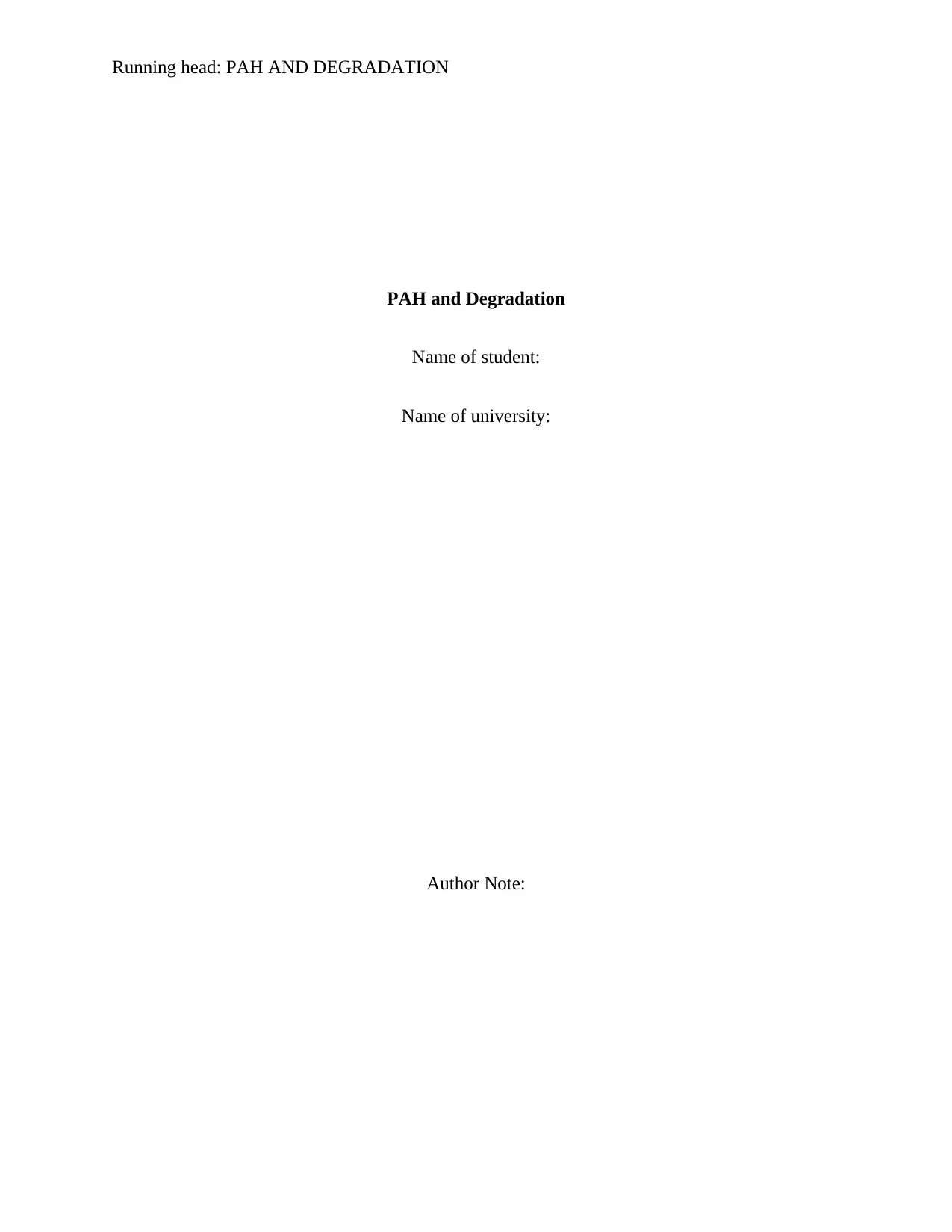
Running head: PAH AND DEGRADATION
PAH and Degradation
Name of student:
Name of university:
Author Note:
PAH and Degradation
Name of student:
Name of university:
Author Note:
Paraphrase This Document
Need a fresh take? Get an instant paraphrase of this document with our AI Paraphraser
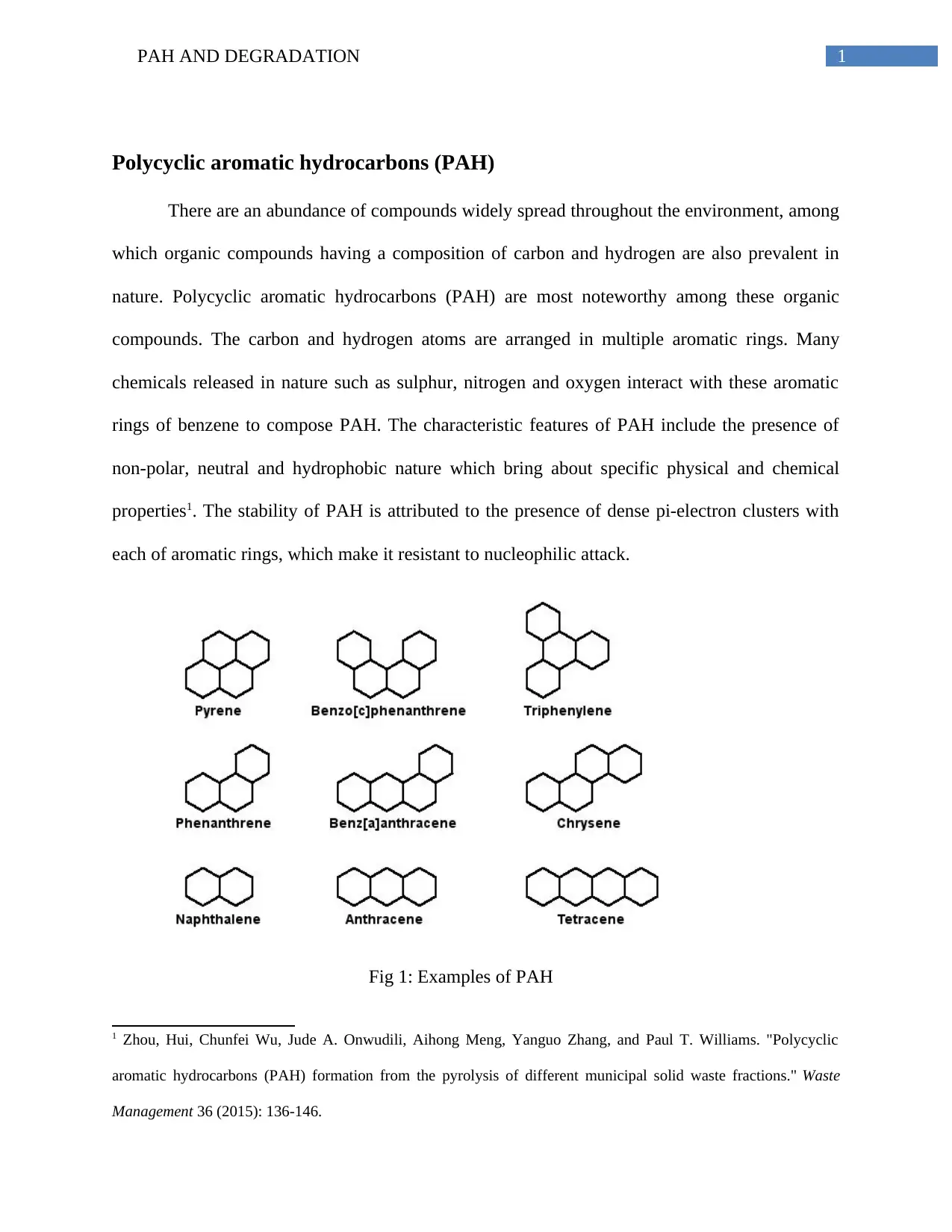
1PAH AND DEGRADATION
Polycyclic aromatic hydrocarbons (PAH)
There are an abundance of compounds widely spread throughout the environment, among
which organic compounds having a composition of carbon and hydrogen are also prevalent in
nature. Polycyclic aromatic hydrocarbons (PAH) are most noteworthy among these organic
compounds. The carbon and hydrogen atoms are arranged in multiple aromatic rings. Many
chemicals released in nature such as sulphur, nitrogen and oxygen interact with these aromatic
rings of benzene to compose PAH. The characteristic features of PAH include the presence of
non-polar, neutral and hydrophobic nature which bring about specific physical and chemical
properties1. The stability of PAH is attributed to the presence of dense pi-electron clusters with
each of aromatic rings, which make it resistant to nucleophilic attack.
Fig 1: Examples of PAH
1 Zhou, Hui, Chunfei Wu, Jude A. Onwudili, Aihong Meng, Yanguo Zhang, and Paul T. Williams. "Polycyclic
aromatic hydrocarbons (PAH) formation from the pyrolysis of different municipal solid waste fractions." Waste
Management 36 (2015): 136-146.
Polycyclic aromatic hydrocarbons (PAH)
There are an abundance of compounds widely spread throughout the environment, among
which organic compounds having a composition of carbon and hydrogen are also prevalent in
nature. Polycyclic aromatic hydrocarbons (PAH) are most noteworthy among these organic
compounds. The carbon and hydrogen atoms are arranged in multiple aromatic rings. Many
chemicals released in nature such as sulphur, nitrogen and oxygen interact with these aromatic
rings of benzene to compose PAH. The characteristic features of PAH include the presence of
non-polar, neutral and hydrophobic nature which bring about specific physical and chemical
properties1. The stability of PAH is attributed to the presence of dense pi-electron clusters with
each of aromatic rings, which make it resistant to nucleophilic attack.
Fig 1: Examples of PAH
1 Zhou, Hui, Chunfei Wu, Jude A. Onwudili, Aihong Meng, Yanguo Zhang, and Paul T. Williams. "Polycyclic
aromatic hydrocarbons (PAH) formation from the pyrolysis of different municipal solid waste fractions." Waste
Management 36 (2015): 136-146.
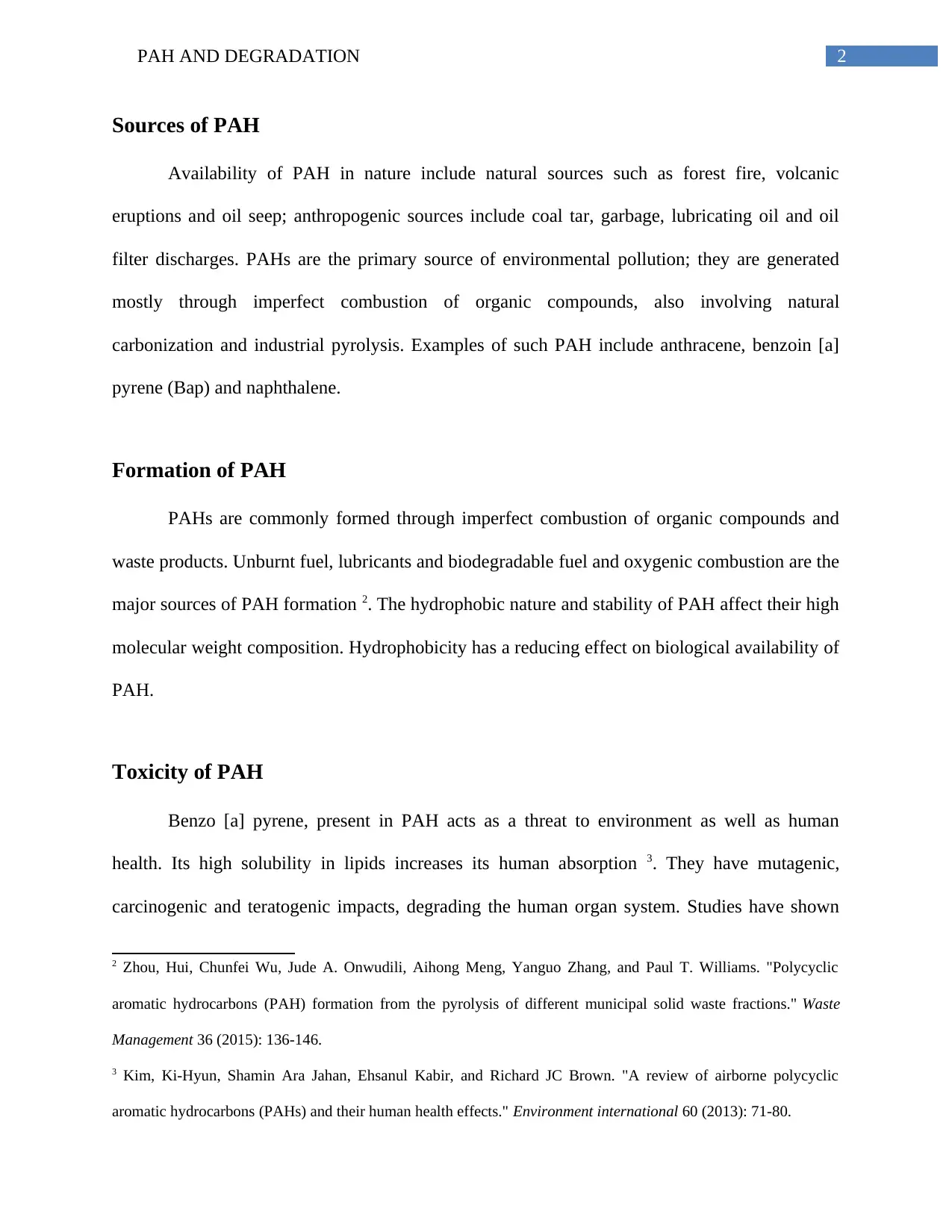
2PAH AND DEGRADATION
Sources of PAH
Availability of PAH in nature include natural sources such as forest fire, volcanic
eruptions and oil seep; anthropogenic sources include coal tar, garbage, lubricating oil and oil
filter discharges. PAHs are the primary source of environmental pollution; they are generated
mostly through imperfect combustion of organic compounds, also involving natural
carbonization and industrial pyrolysis. Examples of such PAH include anthracene, benzoin [a]
pyrene (Bap) and naphthalene.
Formation of PAH
PAHs are commonly formed through imperfect combustion of organic compounds and
waste products. Unburnt fuel, lubricants and biodegradable fuel and oxygenic combustion are the
major sources of PAH formation 2. The hydrophobic nature and stability of PAH affect their high
molecular weight composition. Hydrophobicity has a reducing effect on biological availability of
PAH.
Toxicity of PAH
Benzo [a] pyrene, present in PAH acts as a threat to environment as well as human
health. Its high solubility in lipids increases its human absorption 3. They have mutagenic,
carcinogenic and teratogenic impacts, degrading the human organ system. Studies have shown
2 Zhou, Hui, Chunfei Wu, Jude A. Onwudili, Aihong Meng, Yanguo Zhang, and Paul T. Williams. "Polycyclic
aromatic hydrocarbons (PAH) formation from the pyrolysis of different municipal solid waste fractions." Waste
Management 36 (2015): 136-146.
3 Kim, Ki-Hyun, Shamin Ara Jahan, Ehsanul Kabir, and Richard JC Brown. "A review of airborne polycyclic
aromatic hydrocarbons (PAHs) and their human health effects." Environment international 60 (2013): 71-80.
Sources of PAH
Availability of PAH in nature include natural sources such as forest fire, volcanic
eruptions and oil seep; anthropogenic sources include coal tar, garbage, lubricating oil and oil
filter discharges. PAHs are the primary source of environmental pollution; they are generated
mostly through imperfect combustion of organic compounds, also involving natural
carbonization and industrial pyrolysis. Examples of such PAH include anthracene, benzoin [a]
pyrene (Bap) and naphthalene.
Formation of PAH
PAHs are commonly formed through imperfect combustion of organic compounds and
waste products. Unburnt fuel, lubricants and biodegradable fuel and oxygenic combustion are the
major sources of PAH formation 2. The hydrophobic nature and stability of PAH affect their high
molecular weight composition. Hydrophobicity has a reducing effect on biological availability of
PAH.
Toxicity of PAH
Benzo [a] pyrene, present in PAH acts as a threat to environment as well as human
health. Its high solubility in lipids increases its human absorption 3. They have mutagenic,
carcinogenic and teratogenic impacts, degrading the human organ system. Studies have shown
2 Zhou, Hui, Chunfei Wu, Jude A. Onwudili, Aihong Meng, Yanguo Zhang, and Paul T. Williams. "Polycyclic
aromatic hydrocarbons (PAH) formation from the pyrolysis of different municipal solid waste fractions." Waste
Management 36 (2015): 136-146.
3 Kim, Ki-Hyun, Shamin Ara Jahan, Ehsanul Kabir, and Richard JC Brown. "A review of airborne polycyclic
aromatic hydrocarbons (PAHs) and their human health effects." Environment international 60 (2013): 71-80.
⊘ This is a preview!⊘
Do you want full access?
Subscribe today to unlock all pages.

Trusted by 1+ million students worldwide
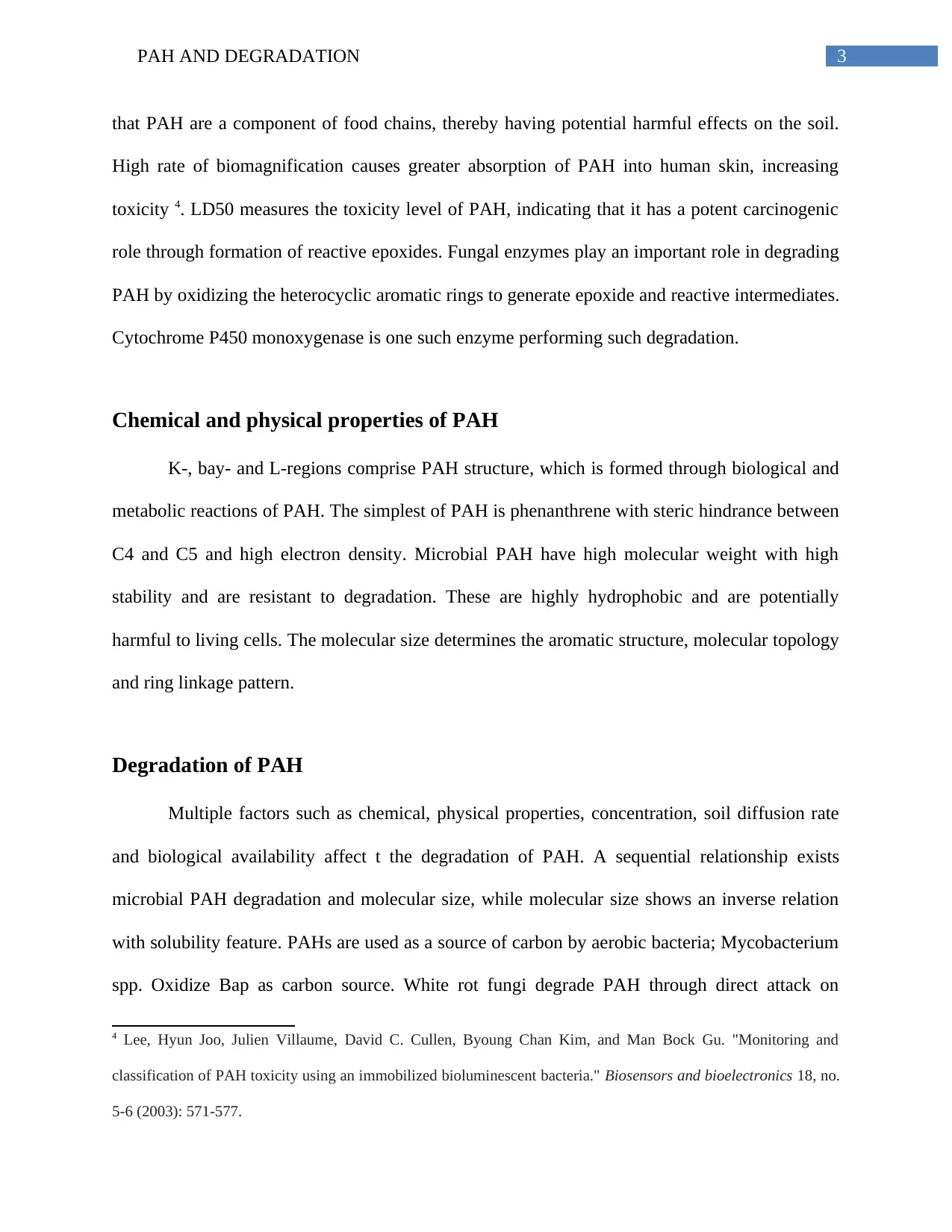
3PAH AND DEGRADATION
that PAH are a component of food chains, thereby having potential harmful effects on the soil.
High rate of biomagnification causes greater absorption of PAH into human skin, increasing
toxicity 4. LD50 measures the toxicity level of PAH, indicating that it has a potent carcinogenic
role through formation of reactive epoxides. Fungal enzymes play an important role in degrading
PAH by oxidizing the heterocyclic aromatic rings to generate epoxide and reactive intermediates.
Cytochrome P450 monoxygenase is one such enzyme performing such degradation.
Chemical and physical properties of PAH
K-, bay- and L-regions comprise PAH structure, which is formed through biological and
metabolic reactions of PAH. The simplest of PAH is phenanthrene with steric hindrance between
C4 and C5 and high electron density. Microbial PAH have high molecular weight with high
stability and are resistant to degradation. These are highly hydrophobic and are potentially
harmful to living cells. The molecular size determines the aromatic structure, molecular topology
and ring linkage pattern.
Degradation of PAH
Multiple factors such as chemical, physical properties, concentration, soil diffusion rate
and biological availability affect t the degradation of PAH. A sequential relationship exists
microbial PAH degradation and molecular size, while molecular size shows an inverse relation
with solubility feature. PAHs are used as a source of carbon by aerobic bacteria; Mycobacterium
spp. Oxidize Bap as carbon source. White rot fungi degrade PAH through direct attack on
4 Lee, Hyun Joo, Julien Villaume, David C. Cullen, Byoung Chan Kim, and Man Bock Gu. "Monitoring and
classification of PAH toxicity using an immobilized bioluminescent bacteria." Biosensors and bioelectronics 18, no.
5-6 (2003): 571-577.
that PAH are a component of food chains, thereby having potential harmful effects on the soil.
High rate of biomagnification causes greater absorption of PAH into human skin, increasing
toxicity 4. LD50 measures the toxicity level of PAH, indicating that it has a potent carcinogenic
role through formation of reactive epoxides. Fungal enzymes play an important role in degrading
PAH by oxidizing the heterocyclic aromatic rings to generate epoxide and reactive intermediates.
Cytochrome P450 monoxygenase is one such enzyme performing such degradation.
Chemical and physical properties of PAH
K-, bay- and L-regions comprise PAH structure, which is formed through biological and
metabolic reactions of PAH. The simplest of PAH is phenanthrene with steric hindrance between
C4 and C5 and high electron density. Microbial PAH have high molecular weight with high
stability and are resistant to degradation. These are highly hydrophobic and are potentially
harmful to living cells. The molecular size determines the aromatic structure, molecular topology
and ring linkage pattern.
Degradation of PAH
Multiple factors such as chemical, physical properties, concentration, soil diffusion rate
and biological availability affect t the degradation of PAH. A sequential relationship exists
microbial PAH degradation and molecular size, while molecular size shows an inverse relation
with solubility feature. PAHs are used as a source of carbon by aerobic bacteria; Mycobacterium
spp. Oxidize Bap as carbon source. White rot fungi degrade PAH through direct attack on
4 Lee, Hyun Joo, Julien Villaume, David C. Cullen, Byoung Chan Kim, and Man Bock Gu. "Monitoring and
classification of PAH toxicity using an immobilized bioluminescent bacteria." Biosensors and bioelectronics 18, no.
5-6 (2003): 571-577.
Paraphrase This Document
Need a fresh take? Get an instant paraphrase of this document with our AI Paraphraser
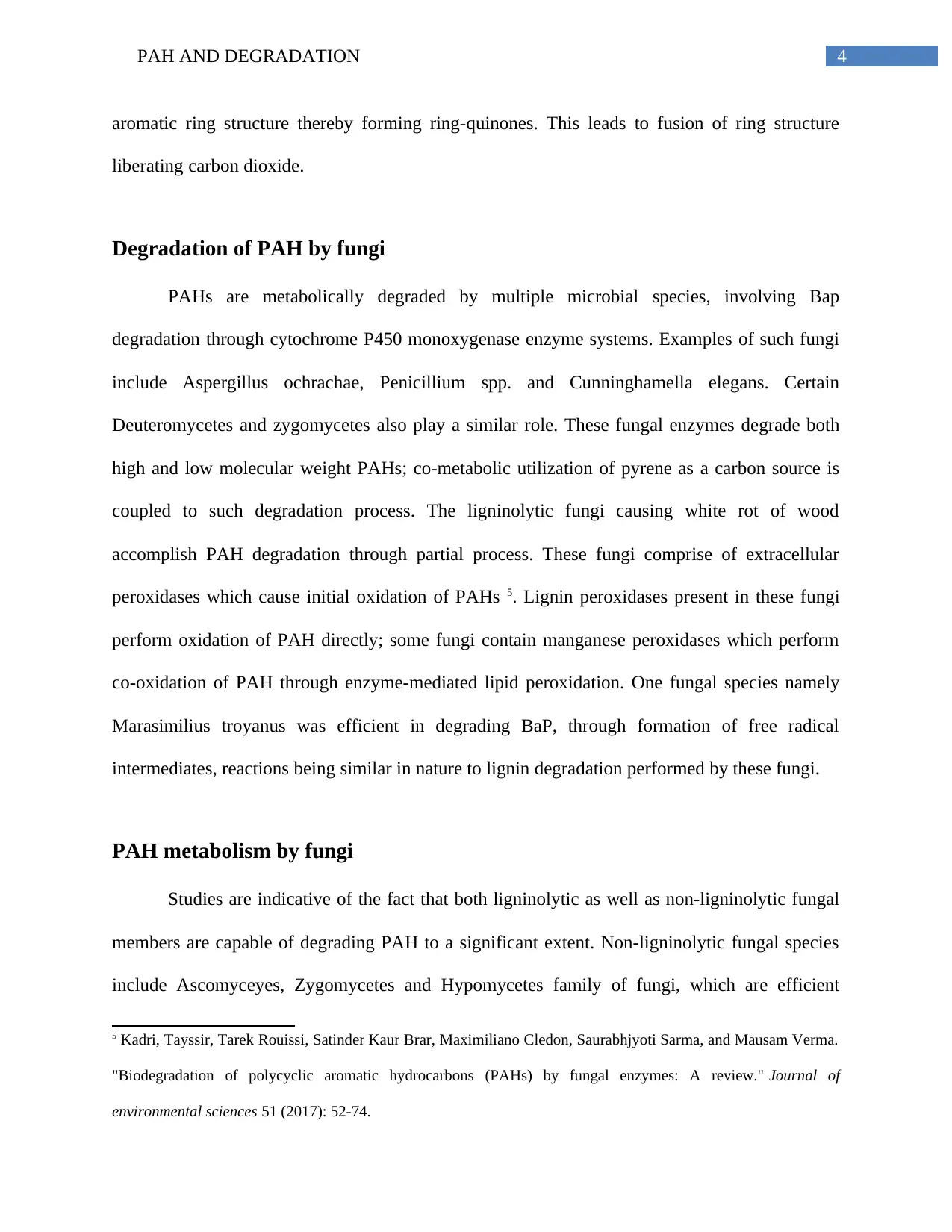
4PAH AND DEGRADATION
aromatic ring structure thereby forming ring-quinones. This leads to fusion of ring structure
liberating carbon dioxide.
Degradation of PAH by fungi
PAHs are metabolically degraded by multiple microbial species, involving Bap
degradation through cytochrome P450 monoxygenase enzyme systems. Examples of such fungi
include Aspergillus ochrachae, Penicillium spp. and Cunninghamella elegans. Certain
Deuteromycetes and zygomycetes also play a similar role. These fungal enzymes degrade both
high and low molecular weight PAHs; co-metabolic utilization of pyrene as a carbon source is
coupled to such degradation process. The ligninolytic fungi causing white rot of wood
accomplish PAH degradation through partial process. These fungi comprise of extracellular
peroxidases which cause initial oxidation of PAHs 5. Lignin peroxidases present in these fungi
perform oxidation of PAH directly; some fungi contain manganese peroxidases which perform
co-oxidation of PAH through enzyme-mediated lipid peroxidation. One fungal species namely
Marasimilius troyanus was efficient in degrading BaP, through formation of free radical
intermediates, reactions being similar in nature to lignin degradation performed by these fungi.
PAH metabolism by fungi
Studies are indicative of the fact that both ligninolytic as well as non-ligninolytic fungal
members are capable of degrading PAH to a significant extent. Non-ligninolytic fungal species
include Ascomyceyes, Zygomycetes and Hypomycetes family of fungi, which are efficient
5 Kadri, Tayssir, Tarek Rouissi, Satinder Kaur Brar, Maximiliano Cledon, Saurabhjyoti Sarma, and Mausam Verma.
"Biodegradation of polycyclic aromatic hydrocarbons (PAHs) by fungal enzymes: A review." Journal of
environmental sciences 51 (2017): 52-74.
aromatic ring structure thereby forming ring-quinones. This leads to fusion of ring structure
liberating carbon dioxide.
Degradation of PAH by fungi
PAHs are metabolically degraded by multiple microbial species, involving Bap
degradation through cytochrome P450 monoxygenase enzyme systems. Examples of such fungi
include Aspergillus ochrachae, Penicillium spp. and Cunninghamella elegans. Certain
Deuteromycetes and zygomycetes also play a similar role. These fungal enzymes degrade both
high and low molecular weight PAHs; co-metabolic utilization of pyrene as a carbon source is
coupled to such degradation process. The ligninolytic fungi causing white rot of wood
accomplish PAH degradation through partial process. These fungi comprise of extracellular
peroxidases which cause initial oxidation of PAHs 5. Lignin peroxidases present in these fungi
perform oxidation of PAH directly; some fungi contain manganese peroxidases which perform
co-oxidation of PAH through enzyme-mediated lipid peroxidation. One fungal species namely
Marasimilius troyanus was efficient in degrading BaP, through formation of free radical
intermediates, reactions being similar in nature to lignin degradation performed by these fungi.
PAH metabolism by fungi
Studies are indicative of the fact that both ligninolytic as well as non-ligninolytic fungal
members are capable of degrading PAH to a significant extent. Non-ligninolytic fungal species
include Ascomyceyes, Zygomycetes and Hypomycetes family of fungi, which are efficient
5 Kadri, Tayssir, Tarek Rouissi, Satinder Kaur Brar, Maximiliano Cledon, Saurabhjyoti Sarma, and Mausam Verma.
"Biodegradation of polycyclic aromatic hydrocarbons (PAHs) by fungal enzymes: A review." Journal of
environmental sciences 51 (2017): 52-74.
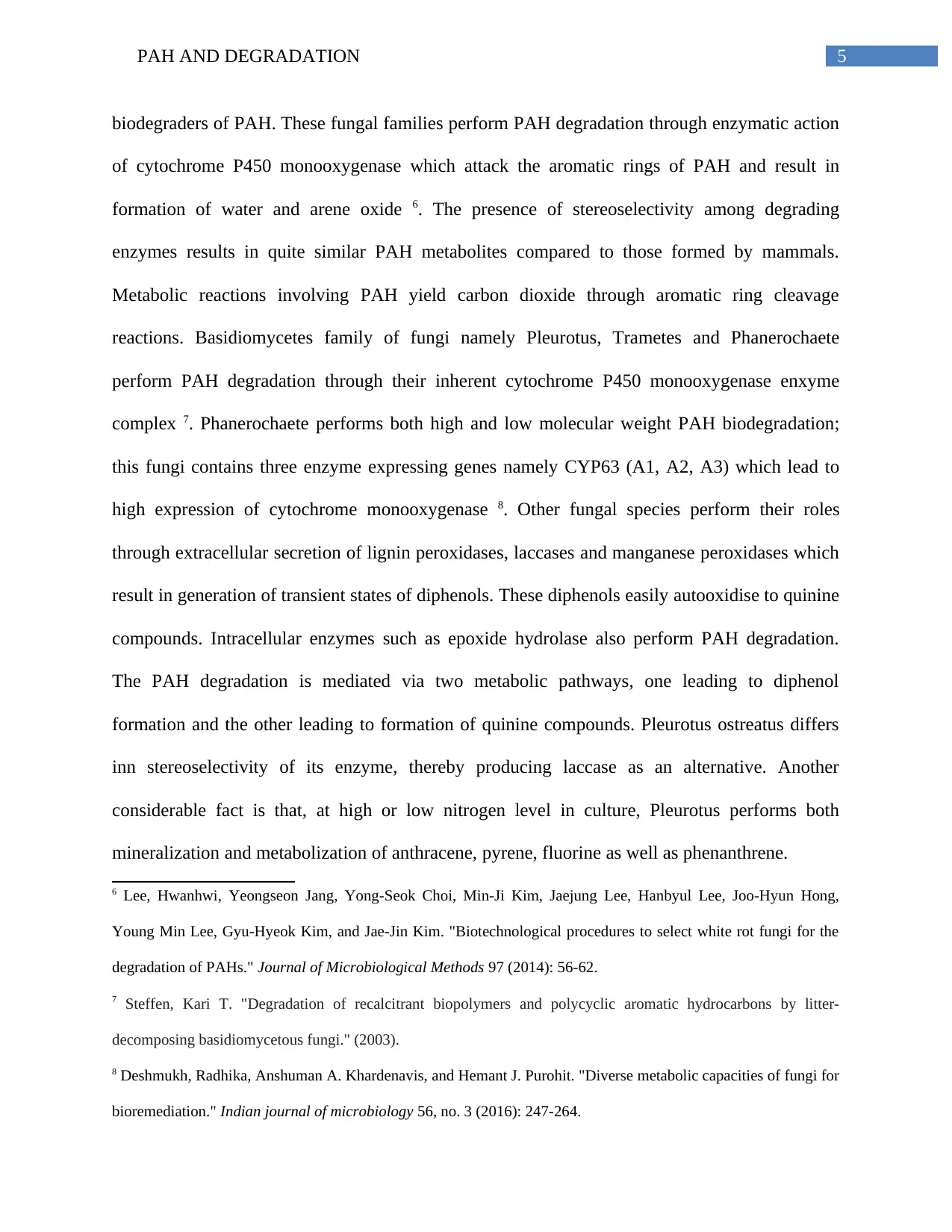
5PAH AND DEGRADATION
biodegraders of PAH. These fungal families perform PAH degradation through enzymatic action
of cytochrome P450 monooxygenase which attack the aromatic rings of PAH and result in
formation of water and arene oxide 6. The presence of stereoselectivity among degrading
enzymes results in quite similar PAH metabolites compared to those formed by mammals.
Metabolic reactions involving PAH yield carbon dioxide through aromatic ring cleavage
reactions. Basidiomycetes family of fungi namely Pleurotus, Trametes and Phanerochaete
perform PAH degradation through their inherent cytochrome P450 monooxygenase enxyme
complex 7. Phanerochaete performs both high and low molecular weight PAH biodegradation;
this fungi contains three enzyme expressing genes namely CYP63 (A1, A2, A3) which lead to
high expression of cytochrome monooxygenase 8. Other fungal species perform their roles
through extracellular secretion of lignin peroxidases, laccases and manganese peroxidases which
result in generation of transient states of diphenols. These diphenols easily autooxidise to quinine
compounds. Intracellular enzymes such as epoxide hydrolase also perform PAH degradation.
The PAH degradation is mediated via two metabolic pathways, one leading to diphenol
formation and the other leading to formation of quinine compounds. Pleurotus ostreatus differs
inn stereoselectivity of its enzyme, thereby producing laccase as an alternative. Another
considerable fact is that, at high or low nitrogen level in culture, Pleurotus performs both
mineralization and metabolization of anthracene, pyrene, fluorine as well as phenanthrene.
6 Lee, Hwanhwi, Yeongseon Jang, Yong-Seok Choi, Min-Ji Kim, Jaejung Lee, Hanbyul Lee, Joo-Hyun Hong,
Young Min Lee, Gyu-Hyeok Kim, and Jae-Jin Kim. "Biotechnological procedures to select white rot fungi for the
degradation of PAHs." Journal of Microbiological Methods 97 (2014): 56-62.
7 Steffen, Kari T. "Degradation of recalcitrant biopolymers and polycyclic aromatic hydrocarbons by litter-
decomposing basidiomycetous fungi." (2003).
8 Deshmukh, Radhika, Anshuman A. Khardenavis, and Hemant J. Purohit. "Diverse metabolic capacities of fungi for
bioremediation." Indian journal of microbiology 56, no. 3 (2016): 247-264.
biodegraders of PAH. These fungal families perform PAH degradation through enzymatic action
of cytochrome P450 monooxygenase which attack the aromatic rings of PAH and result in
formation of water and arene oxide 6. The presence of stereoselectivity among degrading
enzymes results in quite similar PAH metabolites compared to those formed by mammals.
Metabolic reactions involving PAH yield carbon dioxide through aromatic ring cleavage
reactions. Basidiomycetes family of fungi namely Pleurotus, Trametes and Phanerochaete
perform PAH degradation through their inherent cytochrome P450 monooxygenase enxyme
complex 7. Phanerochaete performs both high and low molecular weight PAH biodegradation;
this fungi contains three enzyme expressing genes namely CYP63 (A1, A2, A3) which lead to
high expression of cytochrome monooxygenase 8. Other fungal species perform their roles
through extracellular secretion of lignin peroxidases, laccases and manganese peroxidases which
result in generation of transient states of diphenols. These diphenols easily autooxidise to quinine
compounds. Intracellular enzymes such as epoxide hydrolase also perform PAH degradation.
The PAH degradation is mediated via two metabolic pathways, one leading to diphenol
formation and the other leading to formation of quinine compounds. Pleurotus ostreatus differs
inn stereoselectivity of its enzyme, thereby producing laccase as an alternative. Another
considerable fact is that, at high or low nitrogen level in culture, Pleurotus performs both
mineralization and metabolization of anthracene, pyrene, fluorine as well as phenanthrene.
6 Lee, Hwanhwi, Yeongseon Jang, Yong-Seok Choi, Min-Ji Kim, Jaejung Lee, Hanbyul Lee, Joo-Hyun Hong,
Young Min Lee, Gyu-Hyeok Kim, and Jae-Jin Kim. "Biotechnological procedures to select white rot fungi for the
degradation of PAHs." Journal of Microbiological Methods 97 (2014): 56-62.
7 Steffen, Kari T. "Degradation of recalcitrant biopolymers and polycyclic aromatic hydrocarbons by litter-
decomposing basidiomycetous fungi." (2003).
8 Deshmukh, Radhika, Anshuman A. Khardenavis, and Hemant J. Purohit. "Diverse metabolic capacities of fungi for
bioremediation." Indian journal of microbiology 56, no. 3 (2016): 247-264.
⊘ This is a preview!⊘
Do you want full access?
Subscribe today to unlock all pages.

Trusted by 1+ million students worldwide
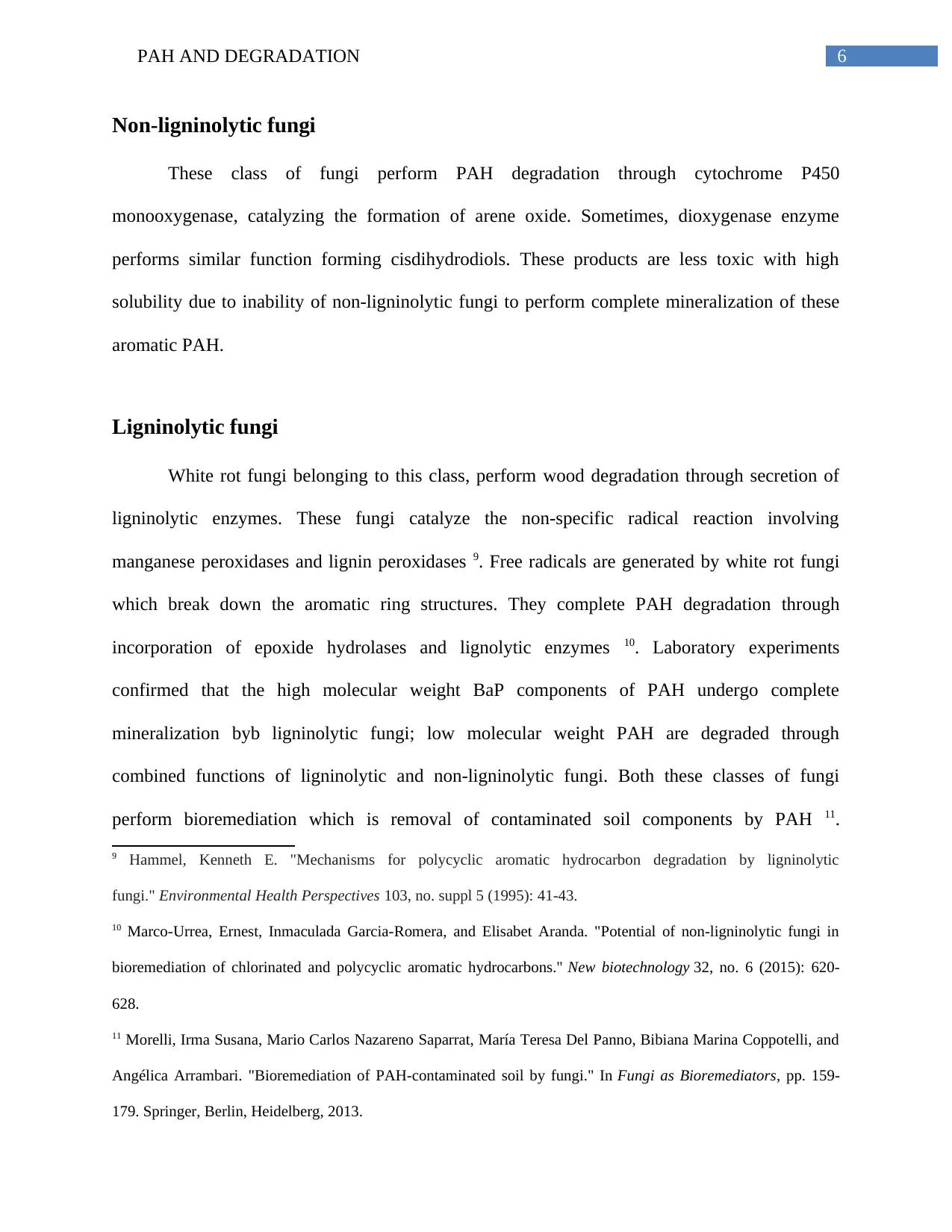
6PAH AND DEGRADATION
Non-ligninolytic fungi
These class of fungi perform PAH degradation through cytochrome P450
monooxygenase, catalyzing the formation of arene oxide. Sometimes, dioxygenase enzyme
performs similar function forming cisdihydrodiols. These products are less toxic with high
solubility due to inability of non-ligninolytic fungi to perform complete mineralization of these
aromatic PAH.
Ligninolytic fungi
White rot fungi belonging to this class, perform wood degradation through secretion of
ligninolytic enzymes. These fungi catalyze the non-specific radical reaction involving
manganese peroxidases and lignin peroxidases 9. Free radicals are generated by white rot fungi
which break down the aromatic ring structures. They complete PAH degradation through
incorporation of epoxide hydrolases and lignolytic enzymes 10. Laboratory experiments
confirmed that the high molecular weight BaP components of PAH undergo complete
mineralization byb ligninolytic fungi; low molecular weight PAH are degraded through
combined functions of ligninolytic and non-ligninolytic fungi. Both these classes of fungi
perform bioremediation which is removal of contaminated soil components by PAH 11.
9 Hammel, Kenneth E. "Mechanisms for polycyclic aromatic hydrocarbon degradation by ligninolytic
fungi." Environmental Health Perspectives 103, no. suppl 5 (1995): 41-43.
10 Marco-Urrea, Ernest, Inmaculada Garcia-Romera, and Elisabet Aranda. "Potential of non-ligninolytic fungi in
bioremediation of chlorinated and polycyclic aromatic hydrocarbons." New biotechnology 32, no. 6 (2015): 620-
628.
11 Morelli, Irma Susana, Mario Carlos Nazareno Saparrat, María Teresa Del Panno, Bibiana Marina Coppotelli, and
Angélica Arrambari. "Bioremediation of PAH-contaminated soil by fungi." In Fungi as Bioremediators, pp. 159-
179. Springer, Berlin, Heidelberg, 2013.
Non-ligninolytic fungi
These class of fungi perform PAH degradation through cytochrome P450
monooxygenase, catalyzing the formation of arene oxide. Sometimes, dioxygenase enzyme
performs similar function forming cisdihydrodiols. These products are less toxic with high
solubility due to inability of non-ligninolytic fungi to perform complete mineralization of these
aromatic PAH.
Ligninolytic fungi
White rot fungi belonging to this class, perform wood degradation through secretion of
ligninolytic enzymes. These fungi catalyze the non-specific radical reaction involving
manganese peroxidases and lignin peroxidases 9. Free radicals are generated by white rot fungi
which break down the aromatic ring structures. They complete PAH degradation through
incorporation of epoxide hydrolases and lignolytic enzymes 10. Laboratory experiments
confirmed that the high molecular weight BaP components of PAH undergo complete
mineralization byb ligninolytic fungi; low molecular weight PAH are degraded through
combined functions of ligninolytic and non-ligninolytic fungi. Both these classes of fungi
perform bioremediation which is removal of contaminated soil components by PAH 11.
9 Hammel, Kenneth E. "Mechanisms for polycyclic aromatic hydrocarbon degradation by ligninolytic
fungi." Environmental Health Perspectives 103, no. suppl 5 (1995): 41-43.
10 Marco-Urrea, Ernest, Inmaculada Garcia-Romera, and Elisabet Aranda. "Potential of non-ligninolytic fungi in
bioremediation of chlorinated and polycyclic aromatic hydrocarbons." New biotechnology 32, no. 6 (2015): 620-
628.
11 Morelli, Irma Susana, Mario Carlos Nazareno Saparrat, María Teresa Del Panno, Bibiana Marina Coppotelli, and
Angélica Arrambari. "Bioremediation of PAH-contaminated soil by fungi." In Fungi as Bioremediators, pp. 159-
179. Springer, Berlin, Heidelberg, 2013.
Paraphrase This Document
Need a fresh take? Get an instant paraphrase of this document with our AI Paraphraser
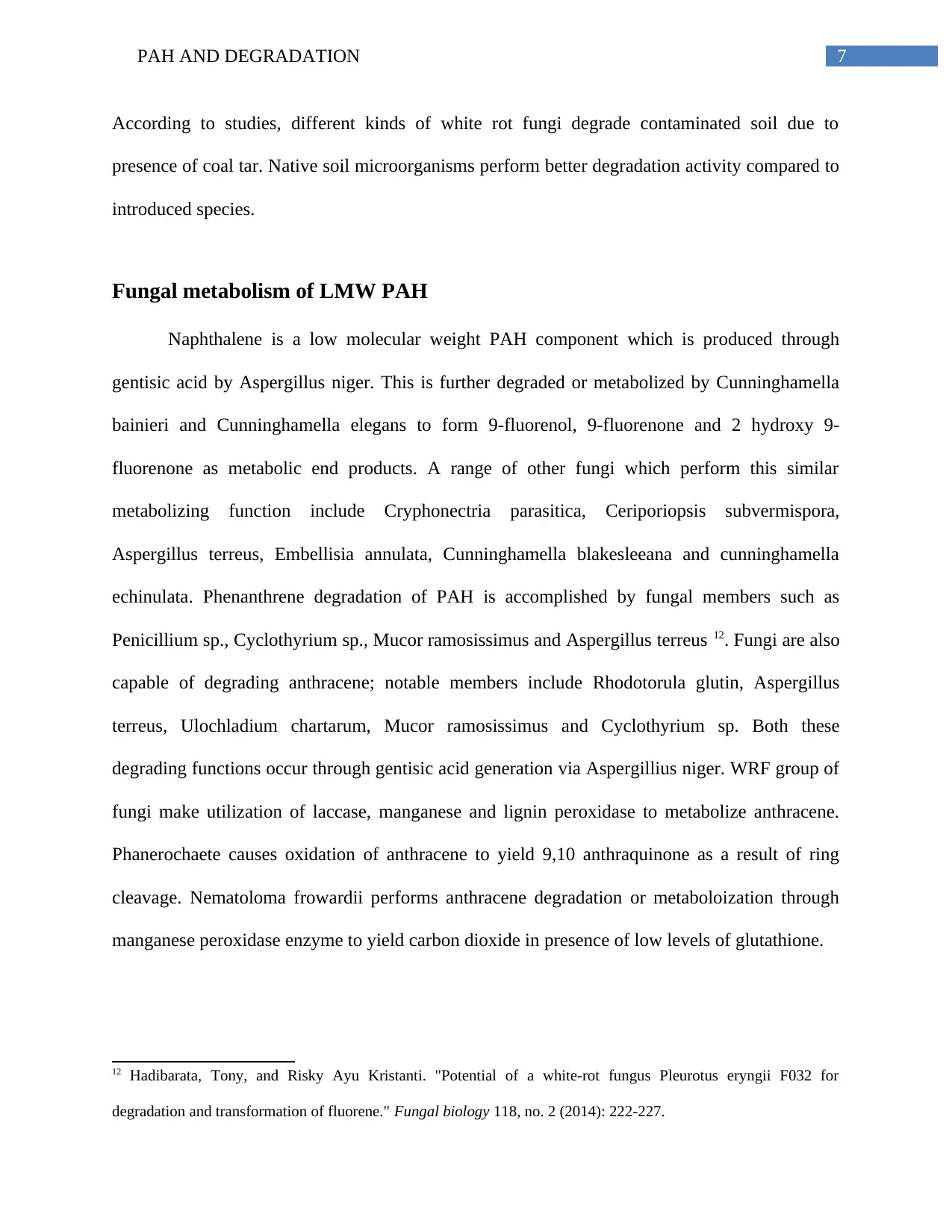
7PAH AND DEGRADATION
According to studies, different kinds of white rot fungi degrade contaminated soil due to
presence of coal tar. Native soil microorganisms perform better degradation activity compared to
introduced species.
Fungal metabolism of LMW PAH
Naphthalene is a low molecular weight PAH component which is produced through
gentisic acid by Aspergillus niger. This is further degraded or metabolized by Cunninghamella
bainieri and Cunninghamella elegans to form 9-fluorenol, 9-fluorenone and 2 hydroxy 9-
fluorenone as metabolic end products. A range of other fungi which perform this similar
metabolizing function include Cryphonectria parasitica, Ceriporiopsis subvermispora,
Aspergillus terreus, Embellisia annulata, Cunninghamella blakesleeana and cunninghamella
echinulata. Phenanthrene degradation of PAH is accomplished by fungal members such as
Penicillium sp., Cyclothyrium sp., Mucor ramosissimus and Aspergillus terreus 12. Fungi are also
capable of degrading anthracene; notable members include Rhodotorula glutin, Aspergillus
terreus, Ulochladium chartarum, Mucor ramosissimus and Cyclothyrium sp. Both these
degrading functions occur through gentisic acid generation via Aspergillius niger. WRF group of
fungi make utilization of laccase, manganese and lignin peroxidase to metabolize anthracene.
Phanerochaete causes oxidation of anthracene to yield 9,10 anthraquinone as a result of ring
cleavage. Nematoloma frowardii performs anthracene degradation or metaboloization through
manganese peroxidase enzyme to yield carbon dioxide in presence of low levels of glutathione.
12 Hadibarata, Tony, and Risky Ayu Kristanti. "Potential of a white-rot fungus Pleurotus eryngii F032 for
degradation and transformation of fluorene." Fungal biology 118, no. 2 (2014): 222-227.
According to studies, different kinds of white rot fungi degrade contaminated soil due to
presence of coal tar. Native soil microorganisms perform better degradation activity compared to
introduced species.
Fungal metabolism of LMW PAH
Naphthalene is a low molecular weight PAH component which is produced through
gentisic acid by Aspergillus niger. This is further degraded or metabolized by Cunninghamella
bainieri and Cunninghamella elegans to form 9-fluorenol, 9-fluorenone and 2 hydroxy 9-
fluorenone as metabolic end products. A range of other fungi which perform this similar
metabolizing function include Cryphonectria parasitica, Ceriporiopsis subvermispora,
Aspergillus terreus, Embellisia annulata, Cunninghamella blakesleeana and cunninghamella
echinulata. Phenanthrene degradation of PAH is accomplished by fungal members such as
Penicillium sp., Cyclothyrium sp., Mucor ramosissimus and Aspergillus terreus 12. Fungi are also
capable of degrading anthracene; notable members include Rhodotorula glutin, Aspergillus
terreus, Ulochladium chartarum, Mucor ramosissimus and Cyclothyrium sp. Both these
degrading functions occur through gentisic acid generation via Aspergillius niger. WRF group of
fungi make utilization of laccase, manganese and lignin peroxidase to metabolize anthracene.
Phanerochaete causes oxidation of anthracene to yield 9,10 anthraquinone as a result of ring
cleavage. Nematoloma frowardii performs anthracene degradation or metaboloization through
manganese peroxidase enzyme to yield carbon dioxide in presence of low levels of glutathione.
12 Hadibarata, Tony, and Risky Ayu Kristanti. "Potential of a white-rot fungus Pleurotus eryngii F032 for
degradation and transformation of fluorene." Fungal biology 118, no. 2 (2014): 222-227.
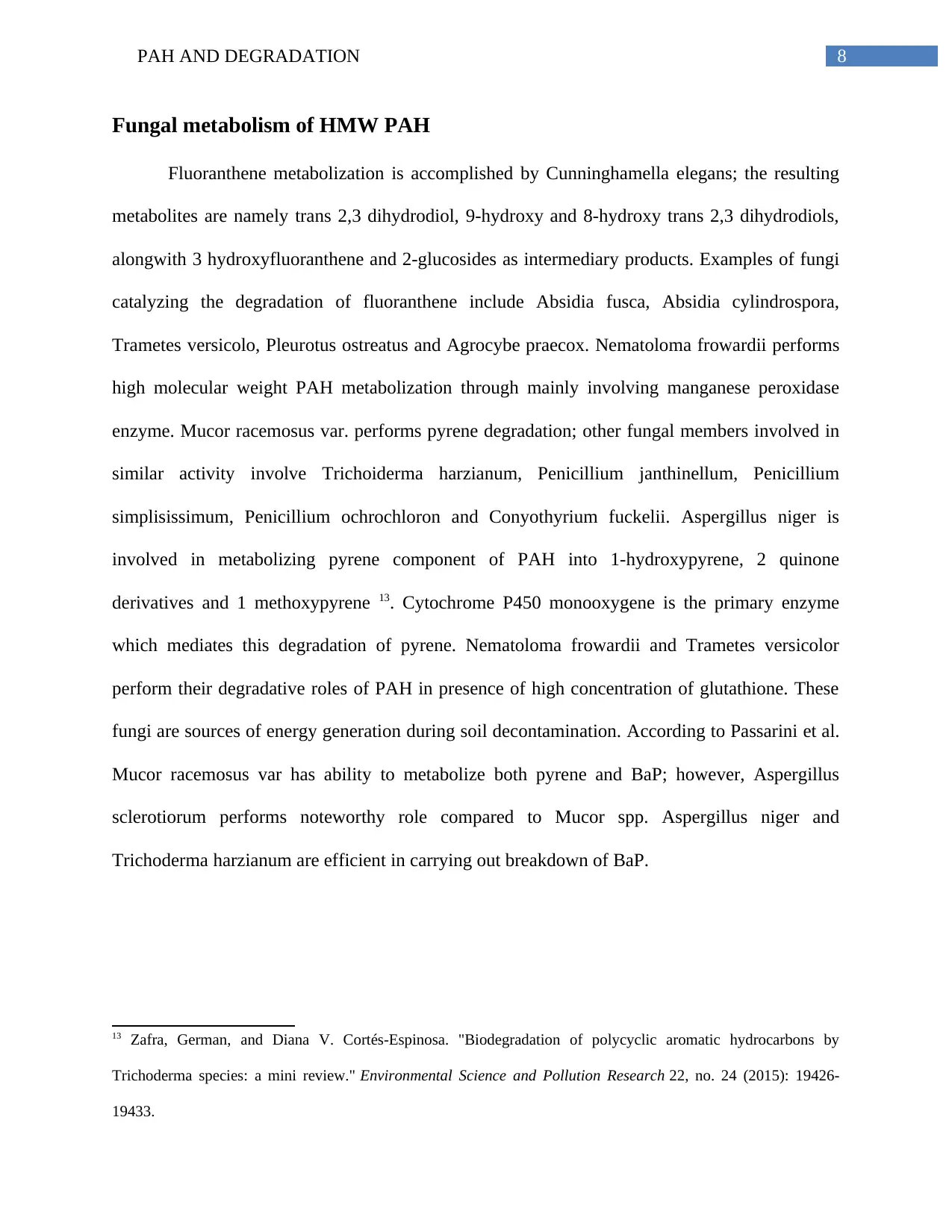
8PAH AND DEGRADATION
Fungal metabolism of HMW PAH
Fluoranthene metabolization is accomplished by Cunninghamella elegans; the resulting
metabolites are namely trans 2,3 dihydrodiol, 9-hydroxy and 8-hydroxy trans 2,3 dihydrodiols,
alongwith 3 hydroxyfluoranthene and 2-glucosides as intermediary products. Examples of fungi
catalyzing the degradation of fluoranthene include Absidia fusca, Absidia cylindrospora,
Trametes versicolo, Pleurotus ostreatus and Agrocybe praecox. Nematoloma frowardii performs
high molecular weight PAH metabolization through mainly involving manganese peroxidase
enzyme. Mucor racemosus var. performs pyrene degradation; other fungal members involved in
similar activity involve Trichoiderma harzianum, Penicillium janthinellum, Penicillium
simplisissimum, Penicillium ochrochloron and Conyothyrium fuckelii. Aspergillus niger is
involved in metabolizing pyrene component of PAH into 1-hydroxypyrene, 2 quinone
derivatives and 1 methoxypyrene 13. Cytochrome P450 monooxygene is the primary enzyme
which mediates this degradation of pyrene. Nematoloma frowardii and Trametes versicolor
perform their degradative roles of PAH in presence of high concentration of glutathione. These
fungi are sources of energy generation during soil decontamination. According to Passarini et al.
Mucor racemosus var has ability to metabolize both pyrene and BaP; however, Aspergillus
sclerotiorum performs noteworthy role compared to Mucor spp. Aspergillus niger and
Trichoderma harzianum are efficient in carrying out breakdown of BaP.
13 Zafra, German, and Diana V. Cortés-Espinosa. "Biodegradation of polycyclic aromatic hydrocarbons by
Trichoderma species: a mini review." Environmental Science and Pollution Research 22, no. 24 (2015): 19426-
19433.
Fungal metabolism of HMW PAH
Fluoranthene metabolization is accomplished by Cunninghamella elegans; the resulting
metabolites are namely trans 2,3 dihydrodiol, 9-hydroxy and 8-hydroxy trans 2,3 dihydrodiols,
alongwith 3 hydroxyfluoranthene and 2-glucosides as intermediary products. Examples of fungi
catalyzing the degradation of fluoranthene include Absidia fusca, Absidia cylindrospora,
Trametes versicolo, Pleurotus ostreatus and Agrocybe praecox. Nematoloma frowardii performs
high molecular weight PAH metabolization through mainly involving manganese peroxidase
enzyme. Mucor racemosus var. performs pyrene degradation; other fungal members involved in
similar activity involve Trichoiderma harzianum, Penicillium janthinellum, Penicillium
simplisissimum, Penicillium ochrochloron and Conyothyrium fuckelii. Aspergillus niger is
involved in metabolizing pyrene component of PAH into 1-hydroxypyrene, 2 quinone
derivatives and 1 methoxypyrene 13. Cytochrome P450 monooxygene is the primary enzyme
which mediates this degradation of pyrene. Nematoloma frowardii and Trametes versicolor
perform their degradative roles of PAH in presence of high concentration of glutathione. These
fungi are sources of energy generation during soil decontamination. According to Passarini et al.
Mucor racemosus var has ability to metabolize both pyrene and BaP; however, Aspergillus
sclerotiorum performs noteworthy role compared to Mucor spp. Aspergillus niger and
Trichoderma harzianum are efficient in carrying out breakdown of BaP.
13 Zafra, German, and Diana V. Cortés-Espinosa. "Biodegradation of polycyclic aromatic hydrocarbons by
Trichoderma species: a mini review." Environmental Science and Pollution Research 22, no. 24 (2015): 19426-
19433.
⊘ This is a preview!⊘
Do you want full access?
Subscribe today to unlock all pages.

Trusted by 1+ million students worldwide
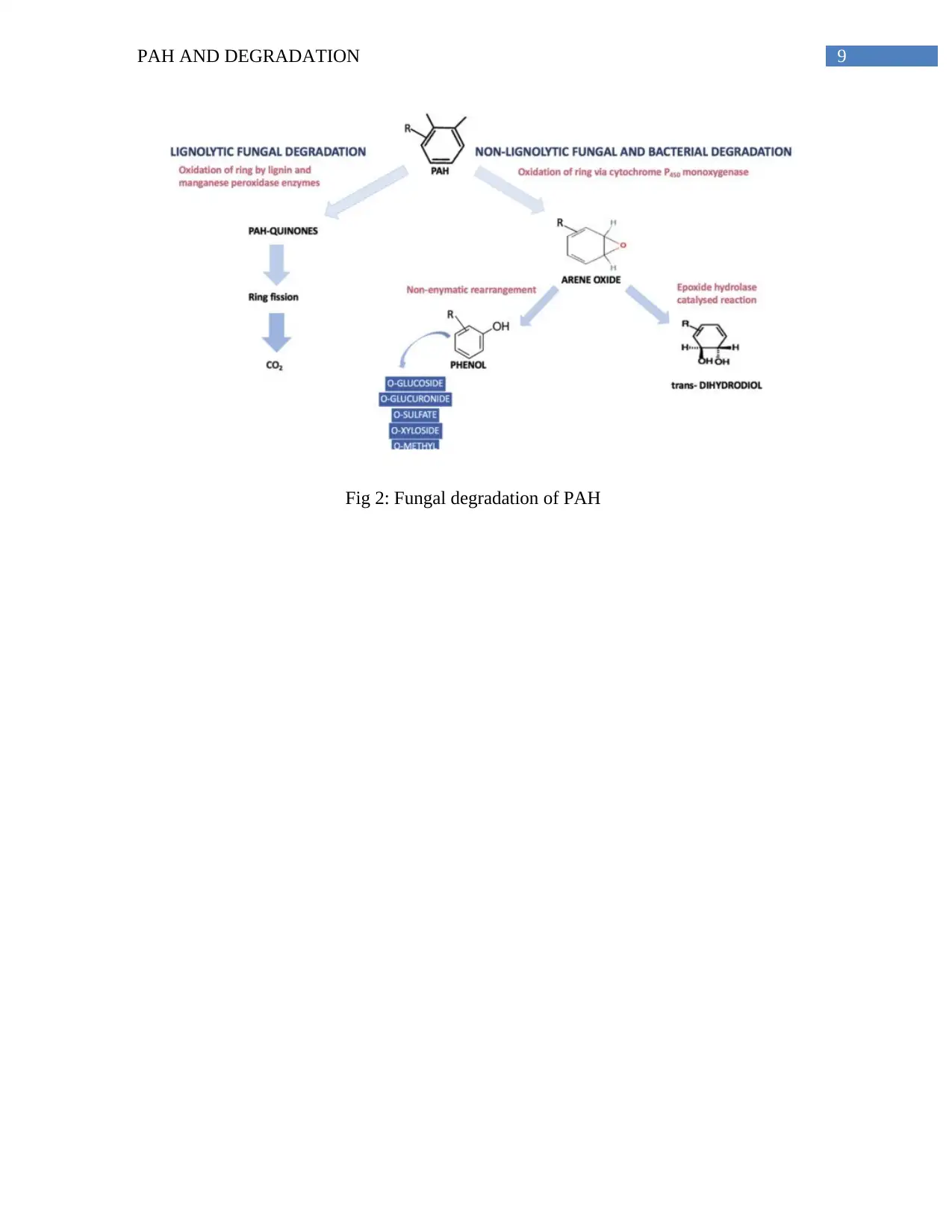
9PAH AND DEGRADATION
Fig 2: Fungal degradation of PAH
Fig 2: Fungal degradation of PAH
Paraphrase This Document
Need a fresh take? Get an instant paraphrase of this document with our AI Paraphraser
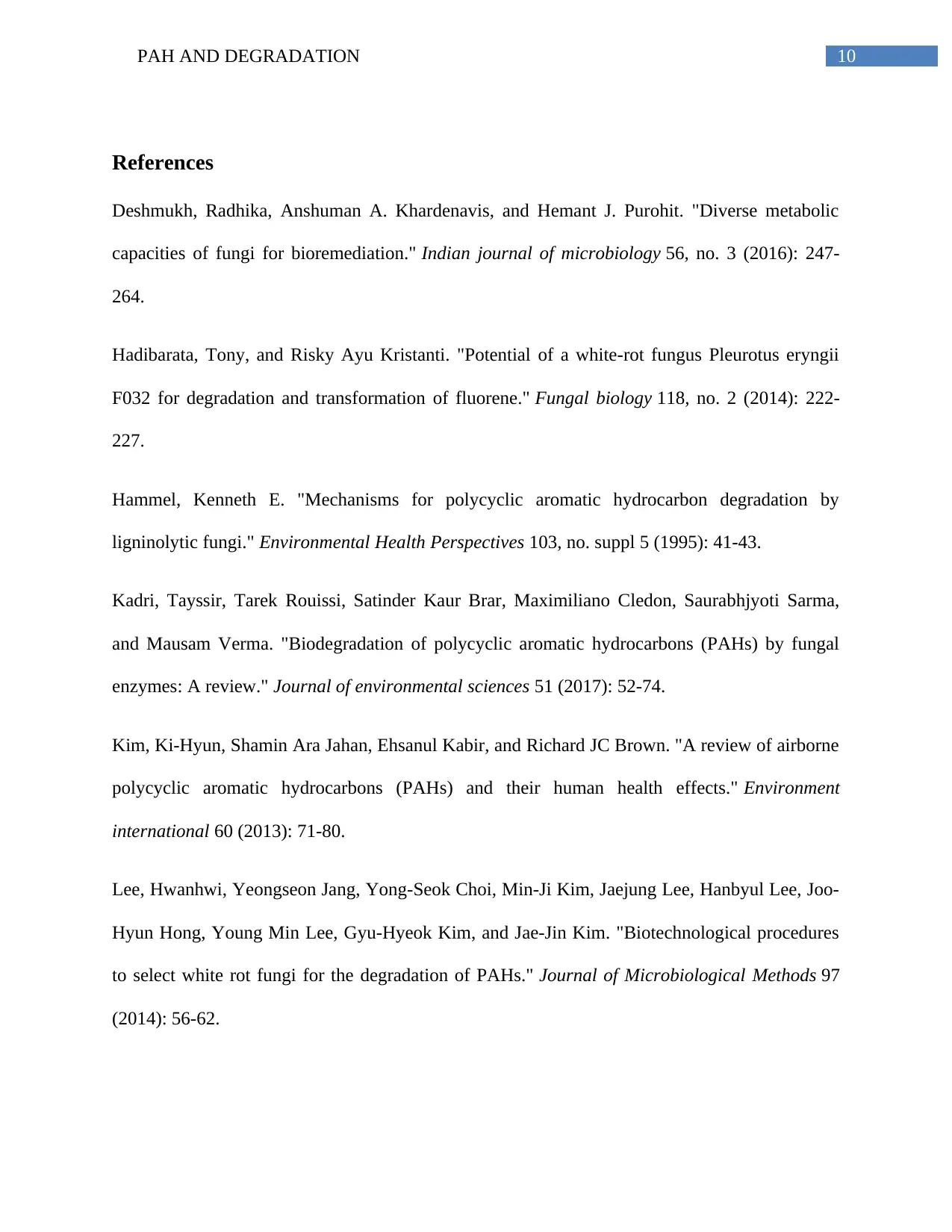
10PAH AND DEGRADATION
References
Deshmukh, Radhika, Anshuman A. Khardenavis, and Hemant J. Purohit. "Diverse metabolic
capacities of fungi for bioremediation." Indian journal of microbiology 56, no. 3 (2016): 247-
264.
Hadibarata, Tony, and Risky Ayu Kristanti. "Potential of a white-rot fungus Pleurotus eryngii
F032 for degradation and transformation of fluorene." Fungal biology 118, no. 2 (2014): 222-
227.
Hammel, Kenneth E. "Mechanisms for polycyclic aromatic hydrocarbon degradation by
ligninolytic fungi." Environmental Health Perspectives 103, no. suppl 5 (1995): 41-43.
Kadri, Tayssir, Tarek Rouissi, Satinder Kaur Brar, Maximiliano Cledon, Saurabhjyoti Sarma,
and Mausam Verma. "Biodegradation of polycyclic aromatic hydrocarbons (PAHs) by fungal
enzymes: A review." Journal of environmental sciences 51 (2017): 52-74.
Kim, Ki-Hyun, Shamin Ara Jahan, Ehsanul Kabir, and Richard JC Brown. "A review of airborne
polycyclic aromatic hydrocarbons (PAHs) and their human health effects." Environment
international 60 (2013): 71-80.
Lee, Hwanhwi, Yeongseon Jang, Yong-Seok Choi, Min-Ji Kim, Jaejung Lee, Hanbyul Lee, Joo-
Hyun Hong, Young Min Lee, Gyu-Hyeok Kim, and Jae-Jin Kim. "Biotechnological procedures
to select white rot fungi for the degradation of PAHs." Journal of Microbiological Methods 97
(2014): 56-62.
References
Deshmukh, Radhika, Anshuman A. Khardenavis, and Hemant J. Purohit. "Diverse metabolic
capacities of fungi for bioremediation." Indian journal of microbiology 56, no. 3 (2016): 247-
264.
Hadibarata, Tony, and Risky Ayu Kristanti. "Potential of a white-rot fungus Pleurotus eryngii
F032 for degradation and transformation of fluorene." Fungal biology 118, no. 2 (2014): 222-
227.
Hammel, Kenneth E. "Mechanisms for polycyclic aromatic hydrocarbon degradation by
ligninolytic fungi." Environmental Health Perspectives 103, no. suppl 5 (1995): 41-43.
Kadri, Tayssir, Tarek Rouissi, Satinder Kaur Brar, Maximiliano Cledon, Saurabhjyoti Sarma,
and Mausam Verma. "Biodegradation of polycyclic aromatic hydrocarbons (PAHs) by fungal
enzymes: A review." Journal of environmental sciences 51 (2017): 52-74.
Kim, Ki-Hyun, Shamin Ara Jahan, Ehsanul Kabir, and Richard JC Brown. "A review of airborne
polycyclic aromatic hydrocarbons (PAHs) and their human health effects." Environment
international 60 (2013): 71-80.
Lee, Hwanhwi, Yeongseon Jang, Yong-Seok Choi, Min-Ji Kim, Jaejung Lee, Hanbyul Lee, Joo-
Hyun Hong, Young Min Lee, Gyu-Hyeok Kim, and Jae-Jin Kim. "Biotechnological procedures
to select white rot fungi for the degradation of PAHs." Journal of Microbiological Methods 97
(2014): 56-62.
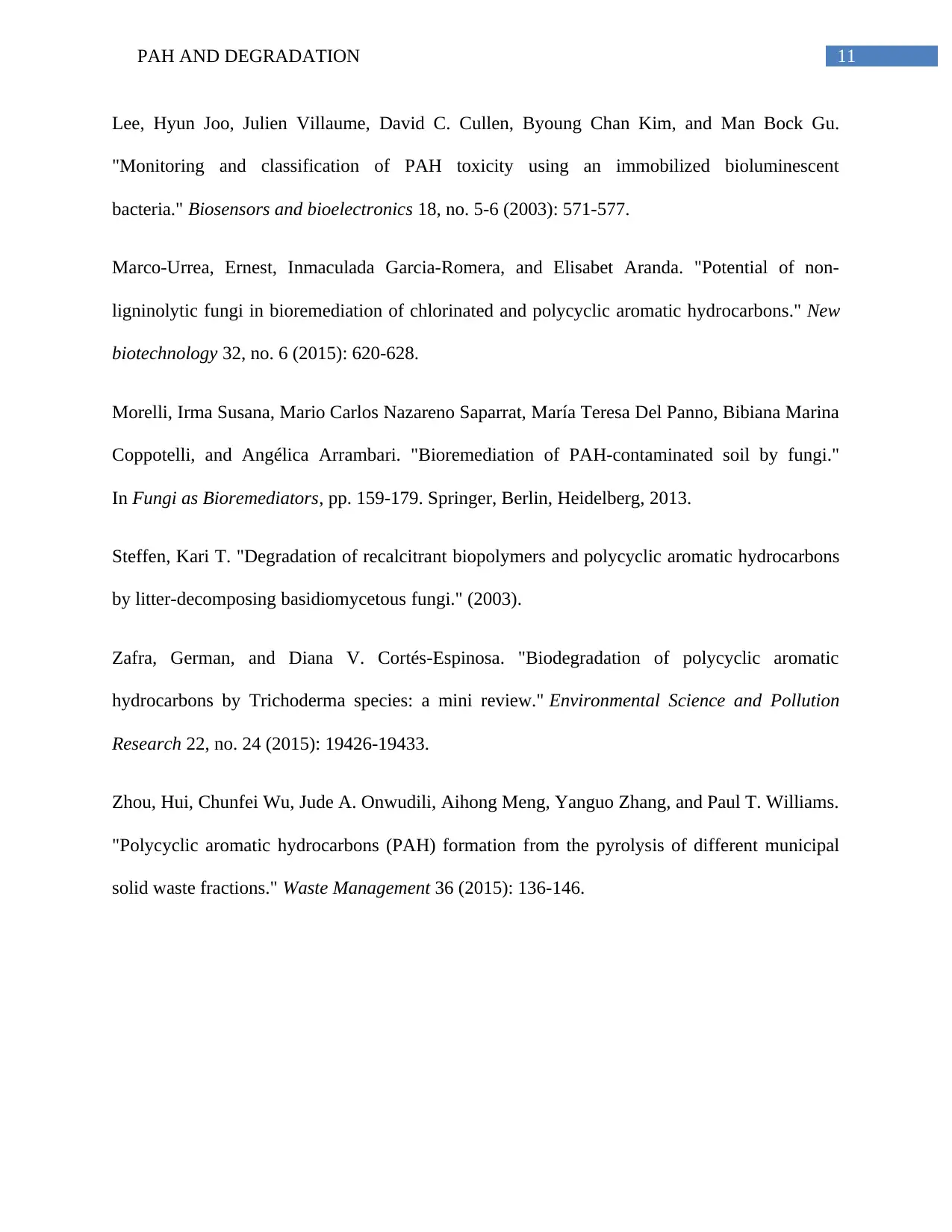
11PAH AND DEGRADATION
Lee, Hyun Joo, Julien Villaume, David C. Cullen, Byoung Chan Kim, and Man Bock Gu.
"Monitoring and classification of PAH toxicity using an immobilized bioluminescent
bacteria." Biosensors and bioelectronics 18, no. 5-6 (2003): 571-577.
Marco-Urrea, Ernest, Inmaculada Garcia-Romera, and Elisabet Aranda. "Potential of non-
ligninolytic fungi in bioremediation of chlorinated and polycyclic aromatic hydrocarbons." New
biotechnology 32, no. 6 (2015): 620-628.
Morelli, Irma Susana, Mario Carlos Nazareno Saparrat, María Teresa Del Panno, Bibiana Marina
Coppotelli, and Angélica Arrambari. "Bioremediation of PAH-contaminated soil by fungi."
In Fungi as Bioremediators, pp. 159-179. Springer, Berlin, Heidelberg, 2013.
Steffen, Kari T. "Degradation of recalcitrant biopolymers and polycyclic aromatic hydrocarbons
by litter-decomposing basidiomycetous fungi." (2003).
Zafra, German, and Diana V. Cortés-Espinosa. "Biodegradation of polycyclic aromatic
hydrocarbons by Trichoderma species: a mini review." Environmental Science and Pollution
Research 22, no. 24 (2015): 19426-19433.
Zhou, Hui, Chunfei Wu, Jude A. Onwudili, Aihong Meng, Yanguo Zhang, and Paul T. Williams.
"Polycyclic aromatic hydrocarbons (PAH) formation from the pyrolysis of different municipal
solid waste fractions." Waste Management 36 (2015): 136-146.
Lee, Hyun Joo, Julien Villaume, David C. Cullen, Byoung Chan Kim, and Man Bock Gu.
"Monitoring and classification of PAH toxicity using an immobilized bioluminescent
bacteria." Biosensors and bioelectronics 18, no. 5-6 (2003): 571-577.
Marco-Urrea, Ernest, Inmaculada Garcia-Romera, and Elisabet Aranda. "Potential of non-
ligninolytic fungi in bioremediation of chlorinated and polycyclic aromatic hydrocarbons." New
biotechnology 32, no. 6 (2015): 620-628.
Morelli, Irma Susana, Mario Carlos Nazareno Saparrat, María Teresa Del Panno, Bibiana Marina
Coppotelli, and Angélica Arrambari. "Bioremediation of PAH-contaminated soil by fungi."
In Fungi as Bioremediators, pp. 159-179. Springer, Berlin, Heidelberg, 2013.
Steffen, Kari T. "Degradation of recalcitrant biopolymers and polycyclic aromatic hydrocarbons
by litter-decomposing basidiomycetous fungi." (2003).
Zafra, German, and Diana V. Cortés-Espinosa. "Biodegradation of polycyclic aromatic
hydrocarbons by Trichoderma species: a mini review." Environmental Science and Pollution
Research 22, no. 24 (2015): 19426-19433.
Zhou, Hui, Chunfei Wu, Jude A. Onwudili, Aihong Meng, Yanguo Zhang, and Paul T. Williams.
"Polycyclic aromatic hydrocarbons (PAH) formation from the pyrolysis of different municipal
solid waste fractions." Waste Management 36 (2015): 136-146.
⊘ This is a preview!⊘
Do you want full access?
Subscribe today to unlock all pages.

Trusted by 1+ million students worldwide
1 out of 13
Your All-in-One AI-Powered Toolkit for Academic Success.
+13062052269
info@desklib.com
Available 24*7 on WhatsApp / Email
![[object Object]](/_next/static/media/star-bottom.7253800d.svg)
Unlock your academic potential
Copyright © 2020–2025 A2Z Services. All Rights Reserved. Developed and managed by ZUCOL.
![Chemical Risk Assessment Report: Benzo[a]pyrene in Biosolids](/_next/image/?url=https%3A%2F%2Fdesklib.com%2Fmedia%2Fimages%2Fck%2F80b1cd28273045d0abdea30a147a23b4.jpg&w=256&q=75)